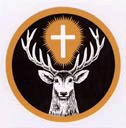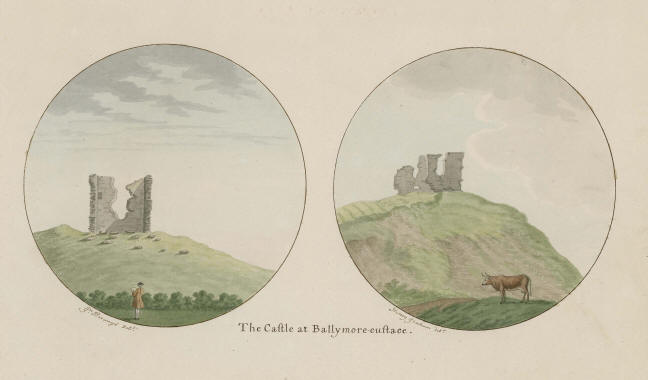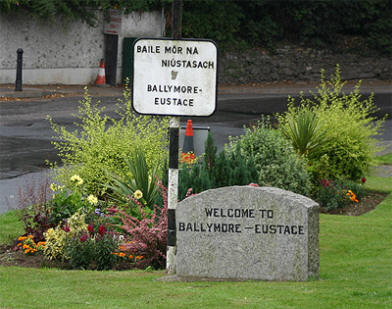|
Ballymore Eustace: The Passing Years
By Reverend Father Lawrence O'Donoghue, PP.
Ballymore Eustace Centenary Book;
pp. 5-6 (1984) Near where the Liffey pours down from Poulaphuca Lake over Goldenfalls (Gouleen an Uisce) the town of Ballymore-Eustace has stood since the end of the twelfth century, bearing the name of Eustace, a Norman family. Previously it laid within the Moy Life lands of Ui Faolăin ancestor of the O’Byrne clan: further south lay the lands of Ui Muirdaigh of Moy Ailbhe where the O’Tooles were settled until both were pushed eastwards to Glenmalure and Castlekevin. One of the cattle raids on Eustace land at Punchestown in 1417 is recorded by Fergainn McKeogh, scribe and poet, that Hugh MacShane O’Byrne raided Baile Fuinse. Baile Fuinse Ca mo mhairg Fa thuirse on lŕ do lomarge ….7rl Ballymore district still bears signs of occupation by people at least 1,000 years before Christ came on earth, such as the Pipers’ Stone Circle measuring 31 feet in diameter at Broadleas, and a forge of the late Bronze Age found thirty years ago at Bishopland containing implements of work in metal. Ruins of ancient churches at Ballybought, Coughlanstown, Tipperkevin and Burgage, indicate Christian communities dotted over the area. These are well-documented in the 1791 report to Archbishop John T. Troy, Archbishop of Dublin (1786-1823) made by Fr. Michael Devoy, PP., Ballymore-Eustace who died in 1810 and whose tombstone in St. John’s Cemetery is still legible, all though the well associated with him has disappeared. The physical layout of the town of Ballymore with its streets running down the slope of the river Liffey, its market house and manor court have changed little. On February 8, 1720 Thomas Sargent is recorded as inn-keeper there. On February 19, 1807 Peter Power and his wife Catherine Nee’ Burke transferred the brewery and land extending down to the Liffey to John Lynch of Whiteleas having been leased in September 1796 by William English of Dublin to John Flinn of Ormond Quay, Dublin, grocer. The rentals of Richard Fitzpatrick of Hanover Square, London for the years 1730-1757 still exist in the possession of the Baron de Robeck of Gowran Grange near Punchestown. Richard Fitz Patrick, a relative of Lord Gowran of Co. Kilkenny had acquired the Commons of Broadleas, along with Ballymore, Dowdenstown, Swordlestown from Richard Arundel of Lanhern, Cornwall. An interesting diary by Lt. John M. Baron de Robeck of 7th Huzzars for the years of 1808, 1815-1847 has also survived and in it he tells how in March 1819 he rode with Lynch of Whiteleas among the tenants in Cryhelp, Lemonstown and Kinsellastown and thought the cabins looked improved and more comfortable than the last time he went there. He had been in Spain with Wellington in the war with Napoleon. Lord Mountcashel’s interests (family name Moore) in 1804 were looked after by Patrick Lysaght of Annefield, Co. Clare until O’Conor Henchy was appointed about 1825. The 1826 Tithe Applotment Book for Ballymore-Eustace and Tipperkevin areas contains a sketch or map of the town of Ballymore as well as giving a full record of names and holdings of heads of families paying tithes. Many of the family surnames are still in the locality. Burke’s Irish Family Records published in 1976 give the family tree of Eustace, Roberts- town, Co. Kildare and Eustace, Annomoe, Co. Wicklow formerly of Galtrim, Dunsany, Co. Meath. Five members of Eustace, Confey, Co. Kildare were allotted lands in the 1654 Cromwellian Transplantation at Kilmacduane, Co. Clare, and the name is still found at Kilmihill, Co. Clare and neighbouring parts of the county. The Eustace name is also found at Manor Kilbride near Blessington, and it is from Eustace of Tipperkevin that Americans of the name trace their origin, now settled in Minnesota and in New York State. The 1821 Report on schools gives details of the hedge schools and parochial schools prior to the Stanley Act, 1832 setting up the National Schools System. Under the Act a school was built in 1835 at Broadleas and at Tipperkevin in 1845. Some Roll Books for these schools survive from 1868,, and 1872 for Tipperkevin. One of the features of the landscape is the number of drumlins and large sandpits of good quality, and earns the name for Kildare—the short grass county. The population too has had its ups and downs according to the records for the Catholic population from 1783 until 1983 (details of other denominations are not available for the same period).
The clearances in all the townlands of Ballymore during the famine are recorded by Fr. Black in 1846 in the parish register 271 heads of families, 49 of these are from Broadleas, 22 from Coughlanstown and 19 from Bishophill. These pages © Ronald Eustice, 2008
|


